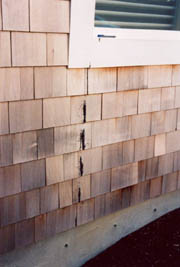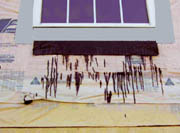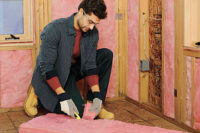It's the phone call that no contractor wants to get. The one where a subcontractor who is flashing the windows calls when the new sealant he is using comes in contact with a self-adhesive flashing product, and adhesive starts coursing down the walls like a waterfall. When the contractor arrives to check it out, there's adhesive and sealant all over the place-except where it belongs. The worst part of it all: There's no way to get it fixed without spending a ton of time and money to figure out what went wrong.
Obviously, preventing water intrusion is very important. Yet, equally important-but oftentimes overlooked-is the compatibility of materials used to protect against moisture damage. Weather-resistive barriers, window flashings and sealants must be effectively integrated with sheathing materials and window fenestrations in order to form a comprehensive moisture control system that keeps water out.
With thousands of building component choices on the market, the opportunity for a materials incompatibility to crop up in unlikely places is increasing all the time-and with it the cost of callbacks and warranty claims when building components fail to work together as intended. So, it is very important to make sure that the building components one chooses form a compatible moisture control system.

Self-adhesive flashing and sealants
Most sealants on the market contain plasticizers. Unfortunately, many of these plasticizer-based sealants have proven to be incompatible with newer self-adhesive flashing products that incorporate rubberized asphalt into their design. When plasticizer-based sealants are used with these self-adhesive flashing products, the rubberized asphalt can be softened and liquefied over time by contact with the incompatible sealant.Figure 1 shows a window installation in which this incompatibility has resulted in the adhesive bleeding from behind the window and flowing onto the exterior cladding. By the time one can see visible evidence of this problem surface, one not only has an angry owner to deal with but also an expensive façade remediation project.
The good news is that these problems can easily be identified and avoided before they are manifested in the field. That's because manufacturers regularly test their materials for incompatibility with other products. In a laboratory setting, various sealants can be applied directly to the rubberized asphalt side of self-adhering flashings. With incompatible sealants, the asphalt will be liquefied by the sealant and then travel along the sealant bead to areas where the sealant is no longer in contact with the asphalt. So, the incompatibility can be found before it causes problems on the job site and leads to costly callbacks.
Select materials from manufacturers who test their products for compatibility. In addition, look carefully for manufacturers' recommendations of compatibility on all flashing and sealant materials used.
Self-adhesive flashing and flexible vinyl products
Rubberized asphalt self-adhesive flashing is universally incompatible with products that are made from flexible vinyl or PVC. Flexible PVC is found in a wide range of products, including roofing, flashing and even some window assemblies. When these products come in contact with each other, the rubberized asphalt breaks down over time by contact with the flexible vinyl, and the protective value of the flashing diminishes because of the plasticizer issues described above. Ultimately, these installations have to be redone at a considerable cost.One example of this incompatibility on the job site was reported when the contractor used a flexible vinyl brick-flashing product in conjunction with rubberized asphalt self-adhesive flashing. The installation had to be completely redone. In Figure 2, the asphalt was liquefied by the plasticizers, causing it to flow onto the housewrap.
Another case in point arose when a contractor used a flanged window that was constructed with a flexible vinyl gasket integrated into the rigid vinyl frame, and then used a rubberized asphalt self-adhesive flashing product to flash the window structure. This installation failed almost immediately and had to be repaired at considerable cost to the contractor.
It is important to note that the incompatibility seen with flexible vinyl products seldom occurs with rigid PVC products. This is due to the fact that rigid PVC materials do not have plasticizers in their chemical makeup. So, the incompatibility with rubberized asphalt self-adhesive flashing does not exist with rigid vinyl windows and their vinyl flanges (assuming that the flanges are not comprised of, or integrated with, flexible PVC materials).

Preventing compatibility problems
As a construction professional, there are a number of things one can do to prevent potential compatibility problems. First and foremost, use only sealants recommended by the manufacturer of the window flashing systems.In addition, the American Architectural Manufacturers Association Window Installations Masters Program does offer guidance with sealant compatibility. AAMA recommends that if the flashing manufacturer does not have a sealant recommendation, then it is critical that the user get documentation from the sealant manufacturer on the compatibility of the sealant with all of the products used in the building assembly.
AAMA also specifies that compatibility with all surfaces that come in direct contact with the sealant is essential. The sealant and any other materials in contact must retain their properties without being affected by one another. Some common indications of sealant incompatibility are evident when the sealant shows signs of hardening, softening, tackiness, loss of adhesion, discoloration or bleeding. When in doubt, always obtain documentation from the manufacturer regarding compatibility between the various materials and the sealant.
When using rigid vinyl windows, look to the window manufacturers to recommend those sealants that are compatible with their products. Look carefully for these recommendations, because they can eliminate the risk of problems later.
When incompatibility problems arise
In the event that there is a compatibility problem, one should immediately contact the manufacturer of each building component involved to find out whether they have any information available on the compatibility of the components being used. Reputable manufacturers are equipped to test their materials in combination with other manufacturers' products. They should actively participate in identifying the source of the compatibility problem-as well as in formulating recommendations for resolution.The safest way to prevent compatibility problems is to work with building materials that have been designed and manufactured to work together as a comprehensive moisture control system. Look for products that come from manufacturers that do sufficient materials testing to warrant their compatibility for your specific use.



